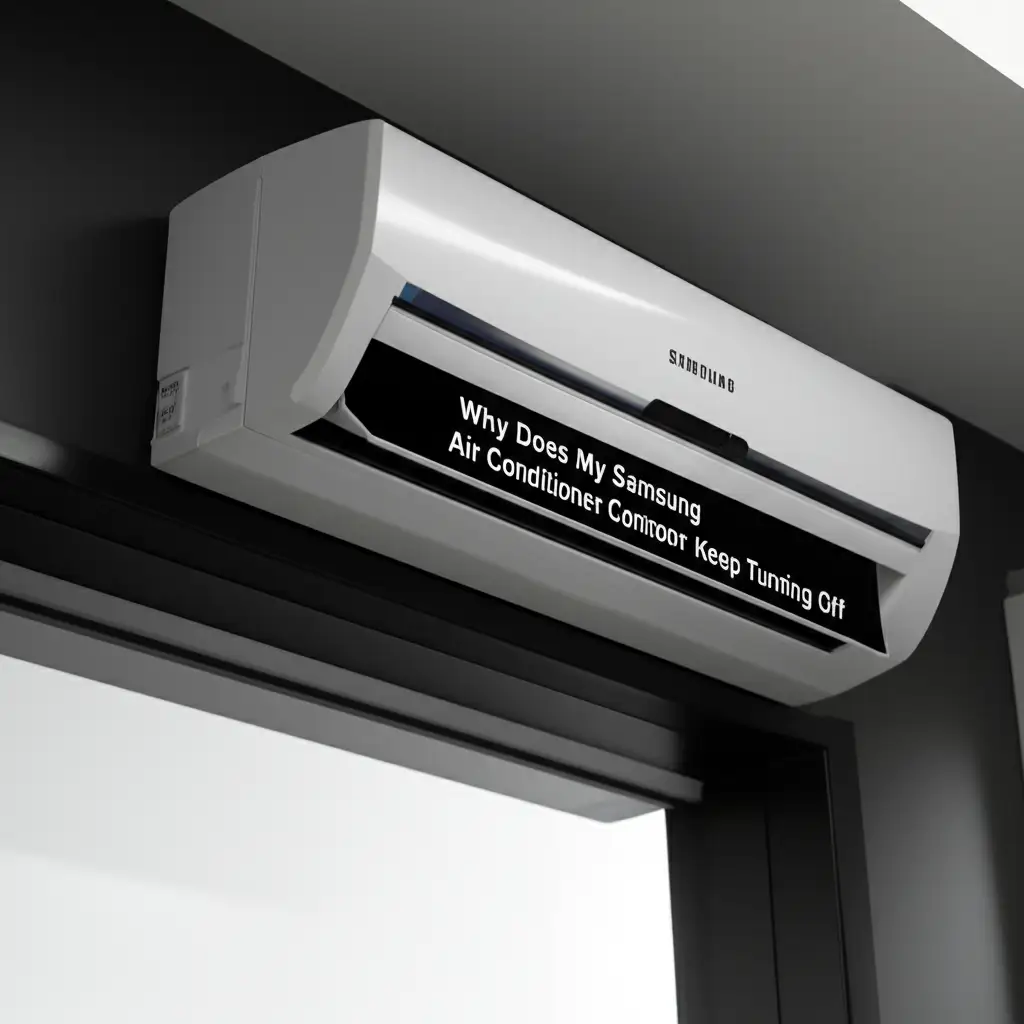· Todd Martin · Home Appliances · 20 min read
How To Change Fahrenheit To Celsius Samsung Air Conditioner

Unlock Optimal Comfort: Change Your Samsung AC from Fahrenheit to Celsius
Imagine settling into your living room, ready to adjust the air conditioning. You reach for the Samsung AC remote, but the numbers look unfamiliar. Many people prefer temperature readings in Celsius, especially if they are used to international standards or simply find Celsius more intuitive for climate control. If your Samsung air conditioner displays temperatures in Fahrenheit and you want to change it to Celsius, you are in the right place. This guide makes the process simple.
Changing your Samsung air conditioner display from Fahrenheit to Celsius is a common need. It ensures you understand your settings instantly. A clear temperature unit helps you achieve perfect indoor comfort. I will walk you through the precise steps to make this switch. We will cover remote control methods, alternative options, and basic troubleshooting. You will also learn about the benefits of using Celsius. Additionally, we will discuss how proper AC maintenance supports all settings. Let us get your Samsung AC showing the temperature exactly as you prefer.
Takeaway
To change your Samsung air conditioner from Fahrenheit to Celsius:
- Locate the specific “mode” or “unit” button on your remote control.
- Press and hold the button for a few seconds until the unit changes.
- Alternatively, check your user manual for model-specific instructions.
- Consider using the Samsung SmartThings app if your AC supports it.
- Ensure remote batteries are fresh for proper function.
To change your Samsung air conditioner from Fahrenheit to Celsius, locate the “Mode” or “Temp” button on your remote control. Press and hold this button for 3-5 seconds. The display unit should switch from Fahrenheit to Celsius. If this does not work, consult your specific model’s user manual or explore options within the Samsung SmartThings app.
Understanding Your Samsung AC Remote Control
Your Samsung air conditioner remote control is the main tool for managing settings. It allows you to adjust temperature, fan speed, and operating modes. Familiarizing yourself with its buttons helps you control your AC easily. Every button serves a specific purpose. Understanding these functions is the first step to changing your temperature unit.
Most Samsung AC remotes have a clear digital display. This display shows the current temperature, operating mode, and fan settings. You will see numerical values for temperature. Next to these numbers, you will usually find either “°F” for Fahrenheit or “°C” for Celsius. Our goal is to switch this indicator. Knowing where to look on the remote is important for success.
Identifying Key Buttons
Samsung remote controls share common button layouts. You will typically find power, mode, fan, and temperature adjustment buttons. For changing temperature units, look for buttons like “Mode,” “Temp,” “Set,” or sometimes a dedicated “°C/°F” button. Not all remotes have a distinct unit button. Often, the function is hidden within another button’s long-press action.
I remember when I first tried to change my AC unit. I pressed every button quickly, but nothing happened. Then, I learned that some functions require a long press. A long press means holding the button down for a few seconds. This action often activates a secondary function. This applies to unit changes on many Samsung AC models. Understanding this detail makes the process much simpler.
Some remotes might have a small hole labeled “Reset” or “Unit Change.” You would need a pen tip or paper clip to press this. Other remotes might integrate this function with the “Mode” or “Fan” buttons. It is good to explore your remote. Pay attention to any small labels or symbols. You can also learn how to change other settings, like how to set the time on your Samsung air conditioner remote, to better understand its functions. This practice helps with all AC adjustments.
Step-by-Step Guide: Changing Temperature Units on Your Remote
Changing the temperature unit on your Samsung air conditioner remote is usually straightforward. Most models follow a similar procedure. You will interact with one or two specific buttons. The key is knowing which buttons to use and how to press them. Let us go through the common methods for this change.
First, make sure your air conditioner is powered on. The remote display should be active. You need to see the current temperature reading. This confirms the remote is communicating with the AC unit. If the remote screen is blank, check the batteries. New batteries ensure the remote sends commands properly.
Method 1: Specific Button Combination
Many Samsung AC remotes allow you to change units with a simple button press. Look for a button that might say “Mode,” “Temp,” or have a dual label like “°C/°F.”
- Point the remote: Aim the remote directly at the indoor air conditioner unit. Make sure there are no obstructions between the remote and the AC.
- Locate the button: Find the “Mode” button. On some older models, it might be the “Temp” button. Some newer models have a small button often hidden under a flap labeled “Unit” or “°C/°F.”
- Press and hold: Press and hold the identified button for approximately 3 to 5 seconds. Do not just press and release. The display on the remote should change from Fahrenheit to Celsius, or vice versa.
- Confirm the change: Look at the digital display on the remote. It should now show “°C” next to the temperature reading instead of “°F.” The AC unit’s display should also update.
I found this method to be the most common. It works for many different Samsung AC models. The waiting period is important. A quick press might only cycle through modes, not change the unit. Be patient and hold the button steady.
Method 2: Menu Navigation (Less Common)
Some advanced Samsung AC models might use a menu system on the remote. This is less common for simple unit changes but can occur.
- Access the menu: Press a “Menu” or “Settings” button. This usually brings up a list of options on the remote’s display.
- Navigate options: Use the arrow buttons (up/down) to scroll through the menu. Look for an option like “Unit,” “Temperature Unit,” or “Display.”
- Select and confirm: Press “OK” or “Set” to select the desired unit (Celsius). The remote display should then update.
This method is more typical for smart thermostats or very high-end AC remotes. Most standard Samsung AC remotes use the direct press-and-hold method. Always check your specific model’s manual if Method 1 does not work. This ensures you are following the correct procedure for your device.
What If Your Remote Doesn’t Have a Unit Button? (Alternative Methods)
Sometimes, the standard methods do not work. Your Samsung AC remote might not have an obvious unit change button. This can be frustrating. However, several alternative methods exist. Do not give up if the first few attempts fail. Specific models might have unique ways to change settings.
One common reason for confusion is that AC remotes vary widely. Different Samsung models come with different remote controls. A remote from five years ago might differ greatly from a brand-new one. The age and series of your air conditioner play a role. Understanding these variations helps you find the right solution.
Checking the User Manual
The user manual is your best friend when troubleshooting appliance settings. Every Samsung air conditioner comes with a detailed manual. This manual provides specific instructions for all functions, including changing temperature units.
- Locate your manual: Find the physical manual that came with your AC unit. If you do not have it, search online.
- Search online: Go to the official Samsung support website. Enter your AC model number. You can usually find the model number on a label on the indoor unit. Download the digital version of the manual.
- Find the relevant section: Look for sections titled “Remote Control Operations,” “Settings,” “Temperature Display,” or “Troubleshooting.” The manual will clearly state how to change Fahrenheit to Celsius.
I always recommend checking the manual first. It gives the exact steps for your specific model. This eliminates guesswork. It can save you a lot of time. Manufacturers design manuals to answer common user questions.
Using the Samsung SmartThings App
Many newer Samsung air conditioners are “smart” appliances. This means you can control them using the Samsung SmartThings app. If your AC supports this feature, the app offers another way to change the temperature unit.
- Download and install: If you have not already, download the Samsung SmartThings app on your smartphone or tablet.
- Connect your AC: Follow the in-app instructions to add your Samsung air conditioner to the app. You will need to be on the same Wi-Fi network as your AC.
- Access settings: Once connected, select your air conditioner within the app. Look for a “Settings” or “Options” icon, often a gear symbol.
- Change temperature unit: Within the settings, you should find an option to switch the temperature unit between Fahrenheit and Celsius. Tap to select your preference.
The SmartThings app offers great convenience. It allows you to control your AC from anywhere. This includes changing units. It is a modern solution for smart home users. This method bypasses the remote control completely. It is very useful if your remote is lost or damaged.
Troubleshooting Common Issues When Changing Units
Sometimes, you follow all the steps, but the unit does not change. This can be frustrating. Several common issues might prevent your Samsung AC from switching from Fahrenheit to Celsius. Do not worry; most problems have simple solutions. We can identify the cause and fix it together.
One frequent problem is the remote control itself. Remotes use batteries, and these batteries can die. If your remote is not sending signals correctly, the AC unit will not respond. Always start your troubleshooting here. A quick check can save a lot of time.
Remote Not Responding
If your remote control seems to do nothing when you press buttons, consider these points:
- Check Batteries: This is the most common issue. Old or dead batteries prevent the remote from working. Replace them with fresh AAA or AA batteries. Ensure they are inserted with correct polarity (+ and -).
- Infrared Sensor: The remote sends an infrared (IR) signal. Make sure the remote’s IR emitter (usually at the front tip) is clean. Ensure the AC unit’s IR receiver (often a small window on the indoor unit) is not blocked. Dust or objects can obstruct the signal.
- Remote Pairing: Some advanced remotes might need to be paired with the AC unit. This is rare for simple temperature unit changes but can occur. Consult your manual for pairing instructions if you suspect this.
- Remote Malfunction: If new batteries and clear line-of-sight do not help, the remote itself might be faulty. Try using the physical buttons on the AC unit, if available, to test if the AC responds.
I have personally experienced issues with old batteries. The remote might light up, but the signal is too weak to reach the AC. Fresh batteries often solve this instantly.
Unit Not Changing
Even if the remote responds, the unit display might not switch. This suggests a different type of issue:
- Wrong Button/Hold Time: Re-read the instructions for your specific model. Are you holding the correct button? Are you holding it for long enough (3-5 seconds)? A quick press might just cycle modes, not change the unit.
- Model Specificity: Not all Samsung AC models support changing temperature units via the remote. Very basic or very old models might not have this feature. Check your user manual to confirm if the feature exists.
- Firmware Glitch: Rarely, a software glitch in the AC unit can prevent settings from changing. You can try a soft reset. Turn off the AC from the main power supply (breaker) for 5-10 minutes, then turn it back on. This can clear temporary errors.
- Internal Issue: If none of the above work, there might be an internal issue with the AC unit’s control board. This is a rare occurrence for a simple unit display change. If you suspect this, contact Samsung support or a qualified technician.
Remember, patience is key during troubleshooting. Go through each step methodically. Most issues related to temperature unit changes are simple and easily resolved.
Benefits of Switching to Celsius for Your Samsung AC
Choosing between Fahrenheit and Celsius for your air conditioner display is more than just a preference. There are practical benefits to using Celsius, especially if you live in a region that primarily uses the metric system. Embracing Celsius can enhance your comfort and understanding of climate control. Let us explore why making this switch can be advantageous.
Firstly, Celsius is the standard temperature scale for most of the world. Countries outside the United States, Liberia, and Myanmar predominantly use Celsius. This global consistency makes it easier to communicate temperature settings if you travel or discuss climate with international friends. It provides a universal language for heat and cold.
Enhanced Precision and Intuition
Celsius offers a more intuitive scale for common weather and human comfort.
- Water’s Boiling/Freezing Points: Celsius is based on water’s properties: 0°C for freezing and 100°C for boiling. This makes it easy to grasp fundamental temperature points. Fahrenheit’s points (32°F and 212°F) are less intuitive for everyday use.
- Smaller Increments: Each degree Celsius represents a larger change in temperature compared to Fahrenheit. This means Celsius often feels more precise when discussing comfort ranges. For instance, a change from 22°C to 23°C feels like a noticeable adjustment. A change from 72°F to 73°F might feel less significant.
- Relatability to Weather: Daily weather forecasts in many regions are in Celsius. Using Celsius on your AC helps you relate indoor comfort to outdoor conditions. If the forecast says 25°C, you know that setting your AC to 25°C will aim for a similar comfortable temperature indoors. This creates a consistent understanding.
I find Celsius simpler to relate to my personal comfort zone. I know 22-24°C is my ideal range. This range feels more concrete than trying to remember specific Fahrenheit numbers. This personal preference often drives the desire to change the display.
Consistency in a Metric World
If you use other appliances or systems that display in Celsius, having your AC in Celsius creates consistency. Many modern smart home devices, weather stations, and even some kitchen appliances use Celsius by default. For example, some air fryers or ovens might switch between Celsius and Fahrenheit. If you have other appliances that show Celsius, like how to change a Gourmia air fryer from C to F, using Celsius on your AC just makes sense. This helps avoid mental conversions.
Consider the example of cooking. If you have an oven that can switch between Celsius and Fahrenheit, such as knowing how to change a Samsung oven from Celsius to Fahrenheit, maintaining a single unit for all your home appliances simplifies usage. This consistency across devices improves your overall smart home experience. It reduces mental load and ensures you are always on the same page with your appliances.
Ultimately, choosing Celsius for your Samsung AC display provides a clearer, more globally consistent, and often more intuitive understanding of your home’s climate. It integrates better with other metric-based systems you might use. This simple change can make managing your indoor environment easier and more comfortable.
Maintaining Your Samsung AC for Optimal Performance
Changing your Samsung air conditioner’s temperature display is a great step towards customized comfort. However, optimal performance goes beyond just unit settings. Regular maintenance ensures your AC runs efficiently and provides accurate temperature readings. A well-maintained unit is a reliable unit. Neglecting maintenance can lead to various issues, including inaccurate temperature control.
Proper care extends the lifespan of your Samsung air conditioner. It also helps reduce energy consumption. A clean and efficient AC unit does not have to work as hard to cool your space. This means lower energy bills and consistent comfort. I always tell people that small maintenance tasks prevent big problems later.
Regular Filter Cleaning
The air filter is the first line of defense for your AC unit. It traps dust, pollen, and other airborne particles. A dirty filter restricts airflow. This makes your AC work harder, reducing efficiency and potentially affecting cooling performance.
- Frequency: Check your filter every month, especially during peak use seasons. Clean or replace it every 1-3 months.
- Cleaning Steps:
- Turn off the AC unit from the thermostat or circuit breaker.
- Open the front panel of your indoor unit.
- Remove the air filters.
- Vacuum loose dust or rinse with lukewarm water if washable.
- Allow filters to dry completely before reinserting.
- Close the panel and restore power.
Keeping your filter clean is one of the easiest and most impactful maintenance tasks. A clean filter ensures good airflow. It also helps your AC accurately sense room temperature. For more detailed steps, you can refer to resources on how to clean an air conditioner filter.
Professional Servicing
While regular filter cleaning helps, professional servicing is crucial for long-term AC health. Technicians perform thorough inspections and tune-ups. They can identify potential issues before they become major problems.
- Annual Check-ups: Schedule a professional service appointment once a year, ideally before the cooling season begins.
- What they do:
- Clean evaporator and condenser coils. Learn more about how to clean air conditioner coils.
- Check refrigerant levels and inspect for leaks.
- Inspect electrical connections and components.
- Clean the drain line to prevent clogs.
- Check fan motors and blades.
- Verify thermostat accuracy.
Professional cleaning, like how to clean an air conditioner unit, helps maintain system efficiency. It also prevents breakdowns. A technician can spot things you might miss. This proactive approach saves money and ensures reliable operation. They can also address issues like why your window air conditioner turns off by itself.
Proper maintenance, combined with your preferred temperature unit settings, ensures your Samsung air conditioner provides consistent, comfortable, and efficient cooling for years to come. Do not underestimate the power of regular care.
Specific Samsung AC Models and Unit Change Procedures
Samsung produces a wide range of air conditioner models. These include split systems, window units, portable units, and ducted systems. While the general principle of changing Fahrenheit to Celsius often involves the remote, specific steps can vary. Understanding these variations helps you find the correct method for your particular model. Always remember that Samsung designs each model with unique features.
Newer models often integrate more smart features and might use the SmartThings app. Older models might rely solely on the remote. Basic remotes might have a hidden button sequence. Advanced remotes might have a dedicated display setting. Knowing your model number helps you find the precise instructions. You can usually find the model number on a sticker on the side or bottom of the indoor unit.
Ducted Systems vs. Split Systems
The most common types of Samsung AC are split systems and ducted systems.
- Split Systems: These have an indoor unit (mounted on a wall or ceiling) and an outdoor unit. Their remotes are typically handheld. The instructions covered in Method 1 and Method 2 usually apply to split systems. The process on their remote controls is often standardized across many Samsung split models.
- Ducted Systems: These have a central indoor unit that distributes air through ducts to multiple rooms. They typically use a wired wall-mounted thermostat. This thermostat might have a dedicated menu for unit changes. The procedure for a wall-mounted controller will differ from a handheld remote. You might need to press and hold specific buttons on the thermostat itself or navigate a digital menu.
I have seen wall-mounted thermostats with a small pinhole reset button. Pressing this button with a paper clip can sometimes cycle through unit settings. This is a common design for ducted systems. Always refer to the specific manual for your wired thermostat.
Consulting Your Specific Model’s Manual
I cannot stress this enough: your AC unit’s user manual is the definitive guide. It provides the most accurate instructions tailored to your specific model.
- Online Resources: If you cannot find your physical manual, visit the Samsung support website. Enter your model number in the search bar. You will find a downloadable PDF version of your manual.
- Model-Specific Search: Use a search engine to look for “[Your Samsung AC Model Number] change Fahrenheit to Celsius.” This might lead to forum discussions or videos from other users with the same model.
- Samsung Support: If all else fails, contact Samsung customer support. Provide them with your model number. They can guide you through the process or confirm if the feature exists on your unit.
While this article provides general guidance, Samsung’s product range is vast. A small detail in your model’s remote or control panel could be key. Investing a few minutes to find and review your specific manual will ensure you get the exact steps needed. This also helps with understanding other functions of your air conditioner.
FAQ Section
Can all Samsung AC models change temperature units?
No, not all Samsung AC models support changing temperature units. Very old or basic models might not have this feature built into their remote or internal software. Most modern Samsung air conditioners, especially smart models, do offer this functionality. Always check your specific model’s user manual for confirmation.
What if my Samsung AC remote is lost or broken?
If your Samsung AC remote is lost or broken, you have a few options. First, check if your AC unit has physical control buttons on the indoor unit itself. Some models allow basic operations, including mode changes. Second, if your AC is a smart model, you can often control it and change settings via the Samsung SmartThings app on your smartphone. Lastly, you can purchase a replacement remote, ensuring it is compatible with your specific AC model.
Does changing the unit from Fahrenheit to Celsius affect AC performance?
No, changing the display unit from Fahrenheit to Celsius does not affect the actual performance or cooling capacity of your Samsung air conditioner. It only changes how the temperature is displayed on the remote and the unit. The AC’s internal operations, such as compressor cycling and fan speed, remain the same regardless of the display unit. It is purely a cosmetic change for user preference.
Why is my AC still showing the wrong unit after trying everything?
If your Samsung AC still shows the wrong unit after trying all methods, consider a few possibilities. The remote batteries might be low, even if the screen lights up. The remote’s signal might be blocked or the AC unit’s receiver could be faulty. For older models, the feature might not exist. As a last resort, a soft reset of the AC (by turning off power at the breaker for 5-10 minutes) can sometimes resolve minor software glitches. If problems persist, contact Samsung customer support.
Is there a physical switch on the AC unit itself for unit change?
It is very rare for Samsung air conditioner units to have a physical switch for changing Fahrenheit to Celsius directly on the unit. Most temperature unit changes are performed via the remote control or, for smart models, through the Samsung SmartThings app. Wall-mounted wired controllers for ducted systems might have a menu setting or a small pinhole reset button. Always check your model’s specific user manual for precise instructions.
How often should I check my AC settings?
You should check your Samsung AC settings whenever you feel uncomfortable or when the seasons change. It is good practice to review settings at the start of cooling season to ensure desired mode and temperature. You might want to adjust fan speed or special features based on daily comfort needs. Beyond that, occasional checks confirm the display unit remains as you prefer. No need for constant checking once set.
Conclusion
Changing your Samsung air conditioner’s temperature display from Fahrenheit to Celsius is a simple yet impactful adjustment. It helps you customize your home’s climate control to your personal preference. Whether you prefer Celsius for its global standard or simply find it more intuitive, this guide has equipped you with the knowledge to make the switch. Remember, the primary method involves using your remote control, often by pressing and holding the “Mode” or “Temp” button.
We covered steps for various remote types and explored alternative solutions like the Samsung SmartThings app. You now understand how to troubleshoot common issues like unresponsive remotes or stubborn unit displays. We also discussed the clear benefits of using Celsius, from consistency with global standards to enhanced precision. Finally, we emphasized the importance of regular maintenance. Proper care ensures your Samsung air conditioner runs efficiently for years. This also supports all your preferred settings.
You are now ready to take control of your Samsung AC. Enjoy your newly customized temperature display. A well-understood air conditioner leads to a more comfortable living space. If you encounter any challenges, your user manual and Samsung customer support remain valuable resources. Make your Samsung air conditioner truly yours by setting it up exactly how you like it.





